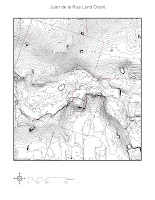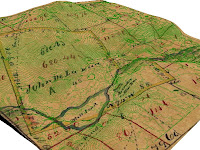Over the last ten weeks, the field school has recovered thousands of distinct pieces of evidence concerning the occupation periods of the Arcadia Mill Village. Some of them have been featured in previous blog posts, but there are quite a few that deserve mentioning now that we have completed excavation and are preparing for a transition from recovery to conservation and analysis.

This iron, depicted
in situ, or in place, was missing its handle. It is possible that we have actually recovered it during the summer's excavations, but since iron artifacts are often almost unrecognizable because of oxidation pre-conservation, it will take a while for us to find it!

We have found several fragments of tableware at Area A. These sorts of finds can "cross-mend" in a fashion similar to ceramics. Individuals of low socioeconomic status would buy their tableware piecemeal as they could afford it, and plantation slaves sometimes received hand-me-downs, so it is unlikely that there is a complete set of silverware out there at Area A. This can make a cross-mend more valuable for tying distinct contexts together through association, because of the greater variety of decorative traditions.


This bottle, as you can see in the wall of one of our units and the scaled image to the left, has a sizeable "kick," which is the convex indentation in the bottom of wine bottles left over from the manufacturing process. Wine bottles change in shape over time as styles of manufacture change, which can provide a source of relative dates on a site.

It was exciting to find evidence of activities at Area A. This frog gig is aptly named for its use in hunting small reptiles and amphibians. Counter-intuitively, people of low socioeconomic status in the past tended to have a
more diverse diet than wealthy individuals, which often resulted in better nutrition for them in the long run!

Faunal remains can give special insight into the diet of historical actors. Earlier, I mentioned the lack of faunal remains in many of our test units. Local soil conditions are sandy, with a high level of acidity. This causes organic material to decay quickly in the absence of something in the soil to neutralize it. Lime from mortar used to hold bricks together is a base, which explains the presence of these teeth in a feature that was notable for its brick and mortar concentration.

It is important for an archaeologist to decide the size of screen to use on an excavation, because small artifacts like this clothing hook can slip through a 1/4" screen unnoticed during sifting. For this reason, we switch to the smaller 1/8" screen when we encounter features.

This piece of white-ware has what is known as a transfer print, a method of imprinting complex and detailed shapes onto the surface of a ceramic dish, cup, or other implement cheaply and quickly. These sorts of ceramic wares were intended for mass-market consumption.
 This iron, depicted in situ, or in place, was missing its handle. It is possible that we have actually recovered it during the summer's excavations, but since iron artifacts are often almost unrecognizable because of oxidation pre-conservation, it will take a while for us to find it!
This iron, depicted in situ, or in place, was missing its handle. It is possible that we have actually recovered it during the summer's excavations, but since iron artifacts are often almost unrecognizable because of oxidation pre-conservation, it will take a while for us to find it! We have found several fragments of tableware at Area A. These sorts of finds can "cross-mend" in a fashion similar to ceramics. Individuals of low socioeconomic status would buy their tableware piecemeal as they could afford it, and plantation slaves sometimes received hand-me-downs, so it is unlikely that there is a complete set of silverware out there at Area A. This can make a cross-mend more valuable for tying distinct contexts together through association, because of the greater variety of decorative traditions.
We have found several fragments of tableware at Area A. These sorts of finds can "cross-mend" in a fashion similar to ceramics. Individuals of low socioeconomic status would buy their tableware piecemeal as they could afford it, and plantation slaves sometimes received hand-me-downs, so it is unlikely that there is a complete set of silverware out there at Area A. This can make a cross-mend more valuable for tying distinct contexts together through association, because of the greater variety of decorative traditions.
 This bottle, as you can see in the wall of one of our units and the scaled image to the left, has a sizeable "kick," which is the convex indentation in the bottom of wine bottles left over from the manufacturing process. Wine bottles change in shape over time as styles of manufacture change, which can provide a source of relative dates on a site.
This bottle, as you can see in the wall of one of our units and the scaled image to the left, has a sizeable "kick," which is the convex indentation in the bottom of wine bottles left over from the manufacturing process. Wine bottles change in shape over time as styles of manufacture change, which can provide a source of relative dates on a site. It was exciting to find evidence of activities at Area A. This frog gig is aptly named for its use in hunting small reptiles and amphibians. Counter-intuitively, people of low socioeconomic status in the past tended to have a more diverse diet than wealthy individuals, which often resulted in better nutrition for them in the long run!
It was exciting to find evidence of activities at Area A. This frog gig is aptly named for its use in hunting small reptiles and amphibians. Counter-intuitively, people of low socioeconomic status in the past tended to have a more diverse diet than wealthy individuals, which often resulted in better nutrition for them in the long run! Faunal remains can give special insight into the diet of historical actors. Earlier, I mentioned the lack of faunal remains in many of our test units. Local soil conditions are sandy, with a high level of acidity. This causes organic material to decay quickly in the absence of something in the soil to neutralize it. Lime from mortar used to hold bricks together is a base, which explains the presence of these teeth in a feature that was notable for its brick and mortar concentration.
Faunal remains can give special insight into the diet of historical actors. Earlier, I mentioned the lack of faunal remains in many of our test units. Local soil conditions are sandy, with a high level of acidity. This causes organic material to decay quickly in the absence of something in the soil to neutralize it. Lime from mortar used to hold bricks together is a base, which explains the presence of these teeth in a feature that was notable for its brick and mortar concentration. It is important for an archaeologist to decide the size of screen to use on an excavation, because small artifacts like this clothing hook can slip through a 1/4" screen unnoticed during sifting. For this reason, we switch to the smaller 1/8" screen when we encounter features.
It is important for an archaeologist to decide the size of screen to use on an excavation, because small artifacts like this clothing hook can slip through a 1/4" screen unnoticed during sifting. For this reason, we switch to the smaller 1/8" screen when we encounter features. This piece of white-ware has what is known as a transfer print, a method of imprinting complex and detailed shapes onto the surface of a ceramic dish, cup, or other implement cheaply and quickly. These sorts of ceramic wares were intended for mass-market consumption.
This piece of white-ware has what is known as a transfer print, a method of imprinting complex and detailed shapes onto the surface of a ceramic dish, cup, or other implement cheaply and quickly. These sorts of ceramic wares were intended for mass-market consumption.











































